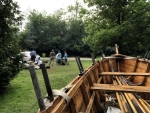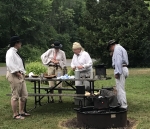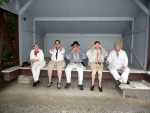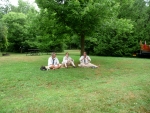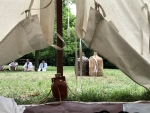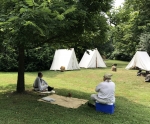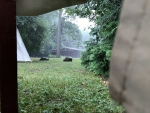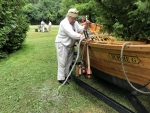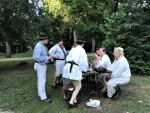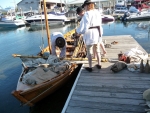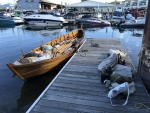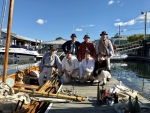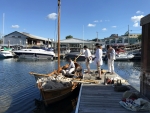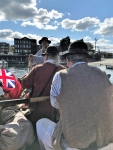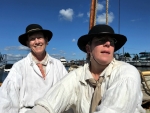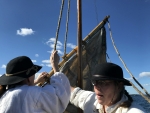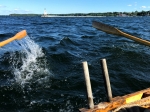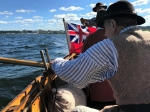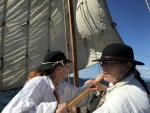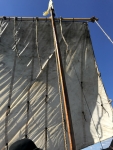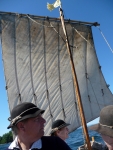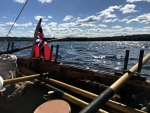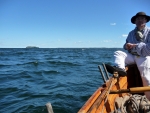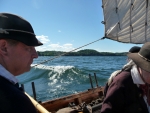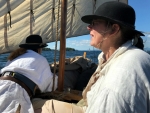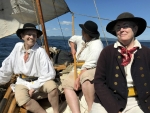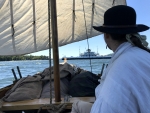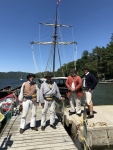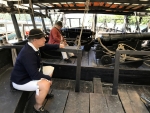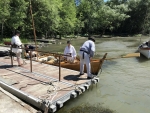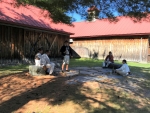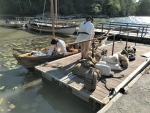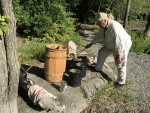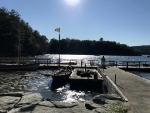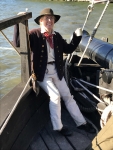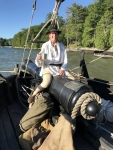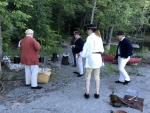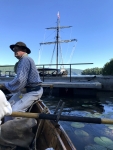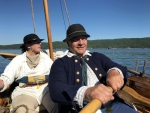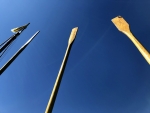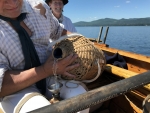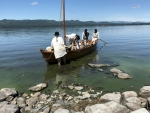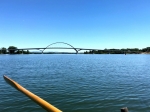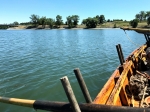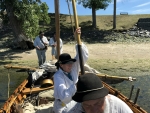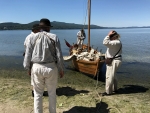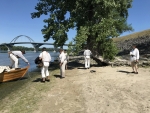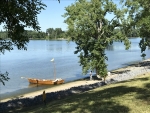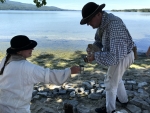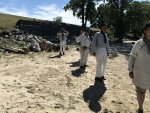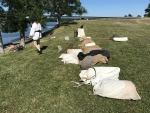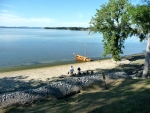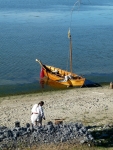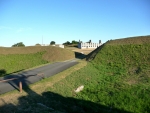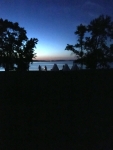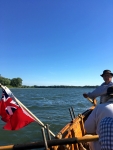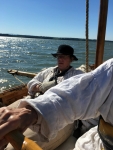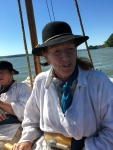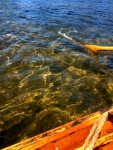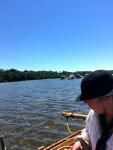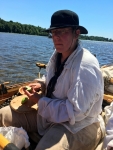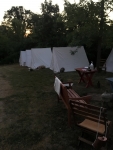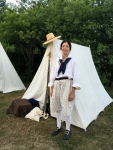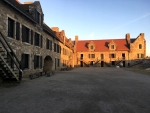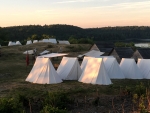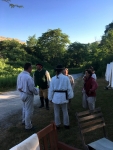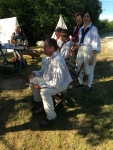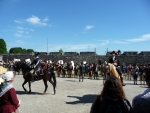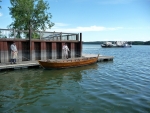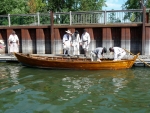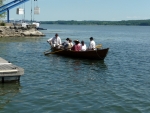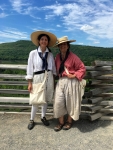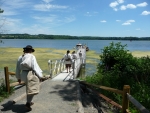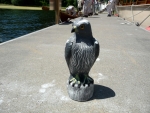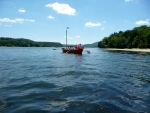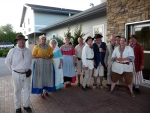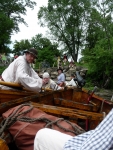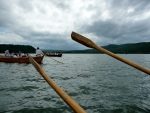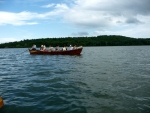Also known as ‘The Big Row, 2018’
Photos were taken by Peggy Huckel, Bill Manthey, and Diane Tso, and are copyright by the person who took them. Text is by myself, David Manthey.
Monday, 16 July 2018 – Grand Isle State Park, Vermont
In our gradual efforts to cover all of the original waterways where Schenectady bateaux originally travelled, this year we decided to start on the eastern side of Lake Champlain and work our way south to Fort Ticonderoga. The first half of the trip will be on water that is new to our bateaux, and the second half of the trip will be largely the same as what we’ve done at other times.
Due to some crew issues, we ended up with no more than seven people on any given day. We decided that it was more prudent to be crowded in one boat than have space and trouble in two. Since this past winter we did a major overhaul of the Bobbie G, and since it is the larger of our two boats, it is the boat of choice.
The starting logistics seem a trifle complicated. Kevin and Rick met at the Mabee Farm and hooked up the two boats to their two vehicles and then proceeded to Fort Ticonderoga. I stopped by and picked up Peggy on my separate way to Fort Ticonderoga. At Fort Ticonderoga we dropped off Rick’s truck and the DeSager and then the four of us proceeded in Kevin’s Jeep and my car, with Kevin pulling the Bobbie G. We made our way to Grand Isle State Park, which could be better signed. Meanwhile, Reb and Judy traveled together from Maine to New Hampshire, then transfered to Bill’s car and proceeded to Grand Isle.
By early evening, we were all at Grand Isle State Park, spread out between two adjacent campsites. We pitched our tents, ate dinner, and fooled around with some gear. We talked with other campers about what we were doing.
Tomorrow’s weather forecast is intimidating – 15 knot southerlies with intermittent torrential cloudbursts. Fortuitously, as part of our planning to have options, if the weather is too contrary for us to handle, we have our current campsites reserved for two nights.
Tuesday, 17 July 2018
One of the hardest lessons about old ways of doing things is the lesson of patience. We are used to largely ignoring the weather and proceeding to do whatever it is that we have planned regardless of the temperature, wind, or precipitation. As forecast, today has a kicking south wind and rain.
We made breakfast of eggs and Rolf’s sausage.
We looked at the whitecaps on the lake and the wind blowing in the wrong direction. We walked a short distance inland where the trees blocked the wind, then went back to the lake and saw the waves again. We repeated this, sometimes hunkering down in a tent or a leanto where we talked, played cards, or otherwise occupied time.
Between rainfalls, we pumped out the boat and started loading it as if we could get going at any time.
In the early afternoon the weather started to look promising, but there were still contrary waves and occasional showers. We’ve done enough rowing trips that we don’t feel like we have to make things harder than necessary, so we were content to stay put.
Eventually the day elapsed without us setting out. We plan for an early morning departure tomorrow. After a group discussion we decided that rather than try to make up our original 16 miles we have planned for today and either exhausting ourselves or always being behind our intended locations, that tomorrow we would launch from Burlington, roughly a half mile from our originally intended camping spot.
Bill made a very tasty dinner of lobscouse, which is a corn beef and ham hash.
Wednesday, 18 July 2018 – Lake Champlain Maritime Museum
We all got up early, pleased that the wind had reversed overnight and was now out of the northwest. We made a breakfast of eggs and bacon, struck camp, and packed up the bateau as best we could on the trailer.
By 8 or so, we had left the campground and were headed to Burlington. As always when we change plans, I wonder if it is the optimum choice. We probably could have made the full distance, but the crew would have been hard pressed.
We parked at Burlington’s Perkins Pier, launched the Bobbie G, then spent some time loading it and making sure the vehicles were secure. We got a passerby to take a picture of us before we set off. Around 9 a.m., we were rowing away from the boat launch and into the lake.
As we were rowing by the end of the breakwater, we stood by to hoist sail. As we started to hoist away, the larboard brace parted. This was surprising, as just a week and a half previously we had gone over all of the lines and they appeared sound. I tried to improvise by tying the ends of the broken brace together, but it just parted again.
We doused the sail, then passed forward a spare brace line. While seizing the spare brace to the yard, we lost a spool of tarred marline. It most likely went overboard with the pitching wave action. After some fussing, we were rerigged and ready to try again.
This time the sail hoisted fine, and we set the braces and sheets to catch the wind. The brisk wind was from just after the starboard beam, and was joined by a lumpy quartering sea. The action of wind and waves produced a decided corkscrew motion. The stern would lift, the boat would twist, the stern drop, the boat would twist back, and the sequence would repeat.
We’ve never sailed in these exact conditions. We made good time, running an average of four miles an hour or so. This had bursts of six or more and lulls of three or less. When the corkscrew action was at its peak, some of the crew felt a shade queasy, which was a first for some of them.
Naturally we had rum call accompanied by cookies. Steering was enough effort and attention that neither myself on the steering oar nor Reb on the whisker boom could take a reasonable break. Judy suggested we needed eighteenth-century sippy cups.
We ran up the lake, seeing only a handful of other boats. One of them was a small inflatable Zodiac-like sailboat that jibed back and forth. We kept approximate pace with it for a while, eventually passing it by as the crew practiced a jibe.
As often, we ate lunch under way, passing out sausage, cheese, bread, apples, grapes, and other sundries.
The wind eased a bit as it approached noon. This was a nice change, as manning the steering oar and the whisker boom were both effortful.
We saw the Essex-Charlotte ferry, and knew we were more than halfway towards our destination for the day. As we approached the path of the ferry, it was just heading west. We were still travelling fast enough that it looked like we could almost pass in front of it. Not wanting the ferry to be unsure of our actions, we deliberately jibed to the larboard, spilling speed, and making it obvious that we would pass astern of the ferry. As soon as this was clear, we jibed back to our preferred course and continued on.
As the lake gradually narrowed, we passed a few more sailboats. We kept relatively close to the Vermont shore, seeing all manner of docks and houses. Being closer to shore, the perception of speed was increased, even as we were going a shade slower due to slightly reduced wind.
We passed a number of small coves, and before long we saw North Harbor. As we steered into the cove, we doused sail and resumed rowing for the first time since getting the sail hoisted near Burlington. Our destination, Lake Champlain Maritime Museum, was just a short row.
Not sure where on the dock there would be space, we first just came alongside one of the pilot boats and secured to it. The crew clambered over the pilot boat to the dock and we took a much needed break.
Once necessary business had been conducted, we greeted the museum staff on the Philadelphia II. There was space free on a work dock that was nicely protected from the wind. We lined the Bobbie G around a variety of boats on the dock, including additional pilot gigs and one of the Charles W. Morgan’s whaleboats. With a few of the crew fending from inside the Bobbie G and the rest helping warp the boat around, we were secured to the work dock without too much effort.
We visited the museum, greeting the staff and talking with other visitors. We sat around and were pleased to have made our desired distance.
Judy’s husband, Bill W., showed up (our rower is Bill M.). He had been knocking about in this truck, visiting various places in Vermont.
We unloaded much of the boat, excepting the tents. We planned to sleep on the Philadelphia II, and the weather looked to remain fair. We lugged the kitchen implements down the dock to shore where Kevin started to prepare dinner.
Once the museum had closed to the public, we situated our various bedding in different spots on the Philly. We had our pick of locations, unlike the time we stayed aboard with a full crew of 44.
Dinner was boiled beef steaks à la Hannah Glasse, potatoes, and sautéed spinach and scallions. It was very tasty.
A satisfying day. 21.3 miles or so.
Thursday, 19 July 2018 – Crown Point Historic Site
We got a slower start today. We had our usual breakfast of eggs and bacon. Bill W. departed; we’ll meet back up with him at Ticonderoga. Even though we didn’t have tents to strike, we still didn’t get underway until shortly after 9.
Today is our shortest day of rowing, and promises to have a light headwind all day. With a full crew, we don’t expect an issue.
As we made our way out of North Harbor, the point was blown over in seagulls. Scotch Bonnet (a small rocky isle) was similarly covered.
Today was a day of solid rowing – taking turns so that no one got too fatigued, refilling canteens as needed, wishing for a little less sun and a more favorable wind, thankful that the wind wasn’t more contrary. As the day progressed we saw a variety of other boats, all under power.
We stopped for a nature break at half past eleven. The ground shoaled into a muddy bottom with enough rocks to keep things interesting but not enough to avoid the mud. We clambered out near the bow. When we clambered back in we brought plenty of mud. Since we refinished the Bobbie G over winter, getting her filthy is more galling than when she was in desperate need of repair.
Lunch was a roving affair, serving out food as we continued to make way.
A few more hours of rowing and we could spot the Champlain Bridge. By 2:45 we had landed on the beach. With the light head winds, we still averaged about two and a half miles an hour.
We first landed fairly far west on the historic site’s beach. We decided further east, closer to the bridge, would be easier to get our gear up the hill. We shifted the boat, then had a shrub and cookie break.
Crown Point has a nice grassy field, but it is upon a higher level above the lake, so everything has to be carted up the hill. We formed a fire-line and handed gear along, placing it halfway to the hill. A second session finished moving the gear to the grassy area. We left the cooking items on the beach. Going up and down was a little slick on the grass with leather-soled shoes.
We started setting up camp. Jack arrived to take away Peggy and Rick – they leave us today, but we are expecting Mary and Diane to join us for tomorrow.
Dinner was a simple ham and potato boil, though everyone seemed to like it well enough.
Once the visitors’ center closed for the day, the nearest restrooms are a fair walk on the other side of the ruins of the English Fort. It turns out the quickest route is actually through the ruins, which is scenic.
Just at the edge of dark, Mary and Diane showed up. They are spending the night in Ticonderoga and will join us tomorrow morning, but wanted to stop by this evening to make sure everything was in order. As soon as the departed, we all turned in for bed.
13.4 miles or so today, for a total of 34.7 so far.
Friday, 20 July 2018 – Fort Ticonderoga
This morning’s breakfast was oyster hash and eggs. It has become a favorite on the rowing trips.
Today there is a headwind that promises to remain all day, blowing from 5 to 15. No sailing for us. A few years back we attempted this same stretch of water with more powerful winds, so we know how hard it can be. Today was not as difficult as that, but it was still work.
We set off a little before nine, and, as soon as we were under the bridge, we started fighting the wind. We shifted around rowers so that no one would be too fatigued.
Although Mary and Diane aren’t as experienced as Peggy and Rick, they are both good traveling companions, willing to pull their fair share of time. They were both very good natured over what turned out to be a fairly hard day.
We worked our way south. Any pause in rowing immediately brought us to a halt with the wind. The wind calmed a little, then rose a little, gradually strengthening overall. It was never as brutal as it could have been, but it was omnipresent.
Steering alternated between trying to get close to shore to have lower wave action and a little more cover from distant trees and standing off to stay out of the devilweed. The rowers were always heckling the steersman to somehow be as out of the wind as possible while still being out of the weeds.
We started to serve lunch as we were nearing the four concrete pylons that are vaguely near the outlet of Putnam Creek. I thought we would be able to pass west of the pylons, but it is very shallow and we ended up running aground. We decided this was a fine time to take a break and eat a leisurely lunch without working against the wind.
Lunch over, we headed back north a short way and then passed by the pylons in the proper channel to their east. In the past I’ve managed to row or paddle to the west of the pylons.
The entire afternoon was spent rowing into the wind. As the day progressed we felt baked by the sun, and any exposed skin felt wind and sunburned, even with modern sunscreen. As needed, we swapped out the steersman, the stroke oar, and rearranged rowers.
We sang songs to help pass the time, lamenting that we don’t remember the tunes to more of the songs in our various songbooks. It is always curious how each person seems to have a subtly different version of particular songs.
At long last we reached the paper plant, worked our way by it, then in a short time saw the ferry. We decided to not stop, but to push on to the Fort’s dock. Everyone was eager to be done for the day.
Finally we saw the Fort’s dock. We worked our way to the south side, as the north side is reserved for the Carillon, rowed passed the dingus that is supposed to scare away birds, and pulled in. The time was between five and six. A variety of friends, including Bill W. were waiting for us. A tough row.
We offloaded gear, then all of the various drivers set out to fetch the cars left at Crown Point and Burlington. Those that remained set up camp. As it took a while to fetch vehicles, by the time we returned we had an informal dinner; the crew dinner was put off until Saturday.
The Fort is a hive of activity – horsemen trotting around, lots of reenactors in various camps and the fort itself. It was very picturesque.
15.2 miles or so today, for a total of 49.9 so far.
Saturday, 21 July 2018
It is always a pleasure to not have to break camp in the morning. After a leisurely breakfast, we launched the DeSager, rowing it around to the Fort’s dock.
Later, a crew of workmen from the Fort came by and manhandled their bateau from where it was onto our trailer. If I had my crew do this, we would have moved the trailer as close as possible and used rollers and finesse. One of the valuable things the Fort brings to reenactments is what can be accomplished by a large number of young men – instead of finesse, they picked their bateau up using 12 or 16 men and just walked it to the trailer. We launched their boat, and they rowed off, arriving at their dock in good order.
In the afternoon, we crewed the Bobbie G and the DeSager, rowing down below the Fort. The Bobbie G was nominally British and the DeSager American. The Bobbie G rowed out, with the intention of sailing by the DeSager at an appropriate time. The DeSager came out firing the swivel gun. The wind did not cooperate, so instead of sailing away, the Bobbie G ended up close to and immediately covered by the DeSager’s swivel.
In the evening, the entire crew went to dinner in Ticonderoga.
Sunday, 22 July 2018
This morning we had an interesting exercise. Later in the day we would be doing a reenactment of evacuating civilians. The bank where they wanted to do this was near the dock. The water between the open lake and this bank was choked with milfoil and other weeds. We had a group of the Fort’s men detached to work on clearing it.
We took all three boats, worked our way into the weeds, and gradually cleared a slot. The goal was to open the waterway enough that the boats could go to shore and back under oars, rather than poling through the weeds. We attempted this clearing by poling into the weeds, then trying to sweep them aside with oars. I had thought that we could uproot enough of the weeds for this to work. Although we moved many weeds, it was not as effective as I was hoping.
A short time after this, we did the evacuation. We took aboard a collection of women reenactors, then rowed south into the lake. Our instructions were to be visible from the fort sometime afterwards, which required us to row as slowly as possible, and, even then, we were too fast. This all went pretty well. Our “refugees” had provisioned themselves with various foodstuffs, which we shared out. We shared stories and generally had a good time, contrary to what actual refugees would experience. We rowed over to Mount Independence, then back.
After we had been out long enough, we returned our refugees to the Fort’s dock, then rowed the boats back to the launch at the ferry. We had to walk to fetch trailers, but were nicely given a lift part of the way. After loading the boats on to the trailers, we went back to camp.
By this time, the main reenactment had wrapped up and people were breaking camp. We did so as well.
By best estimate, total trip distance for the Bobbie G was 56.9 miles and for the DeSager was 8.4 miles.
